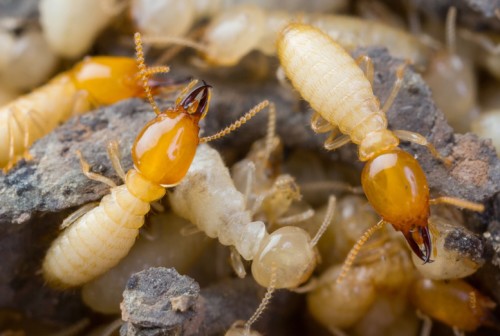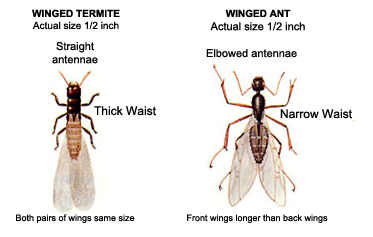
Termite problems are entirely controllable under professional care. Our treatment goal is to stop a problem at its source so it doesn’t keep coming back. Using state-of-the art equipment and methods, our licensed exterminators will inspect your home’s environment and construction to identify the problem and determine the best course of action. Contact us today!
In soil, termites will forage for cellulose material found in plants. Typically you can unearth termites in the mulch surrounding your home or in a nearby wood pile. When soil conditions and temperatures are good for termite activity, colonies can develop near the foundation of your home. As termites forage for food in the soil, they often enter homes through small cracks (1/16 inch wide or less). Once inside they will continue for forage for food and inside the home, the food will typically be wood. This wood can be any structural timber around the foundation, behind walls, in ceilings and in many areas that may go unnoticed for months or years.
The eastern subterranean termite (Reticulitermes flavipes), is the most common termite found in North America. Classified as pests, they are largest species of wood destroying insect in the United States. Termites are able to digest cellulose, the main constituent of wood, using bacteria, protozoa and microbes that live inside their stomachs They are extremely well organized and persistent in their search for new food sources. They will eat any cellulose material including wallpaper, books, boxes, carpet backing, cotton, drywall and even furniture.
A mature colony can range from 20,000 workers to as high as 5 million workers and the primary queen of the colony lays 5,000 to 10,000 eggs per year. Queen termites can live up to decades under ideal climate conditions. Workers and soldiers live approximately one to two years.
Termites usually come out in early spring throughout the North East and at times can be seen as a swarm of what looks like flying ants. Some clues that your home has a termite problem (aside from the spring swarming) will include, soft wood, and mud tubes around the exterior or interior of your house, most likely near the foundation. Also dark or blistered wood structures may also be an indication of a termite problem.
The three most recognizable forms (castes) of the eastern subterranean termite are the swarmers (winged reproductives), soldiers and workers. The swarmers are about 3/8 inch long including wings, dark brown to almost black and have 2 pairs of translucent (slightly milky to slightly smoky) wings. The front and hind wings are of equal size. Soldiers are about 1/4 inch long and have an elongated, amber-colored head armed with long jaws. The body is translucent white and the legs are rather short. Workers are 3/16 to 1/4 inch long, translucent white with a nearly round amber head and have rather short legs.

Getting rid of termites is not easy because of the size and location of the underground colonies. Termites can forage far below the soil for food and will create underground colonies with a series of tunnels and passageways. The termites will mark food sources with a pheromone trail so the other members of the colony can follow a path. The most effective termite control solution is based on careful inspection, observation, and follow up. The final treatment needs to successfully eradicate the entire colony, stopping termite foraging at its source.
Prevention Tips: Although it is impossible to completely prevent termites from entering you’re the typical home, the following steps will help in preventing future infestations: